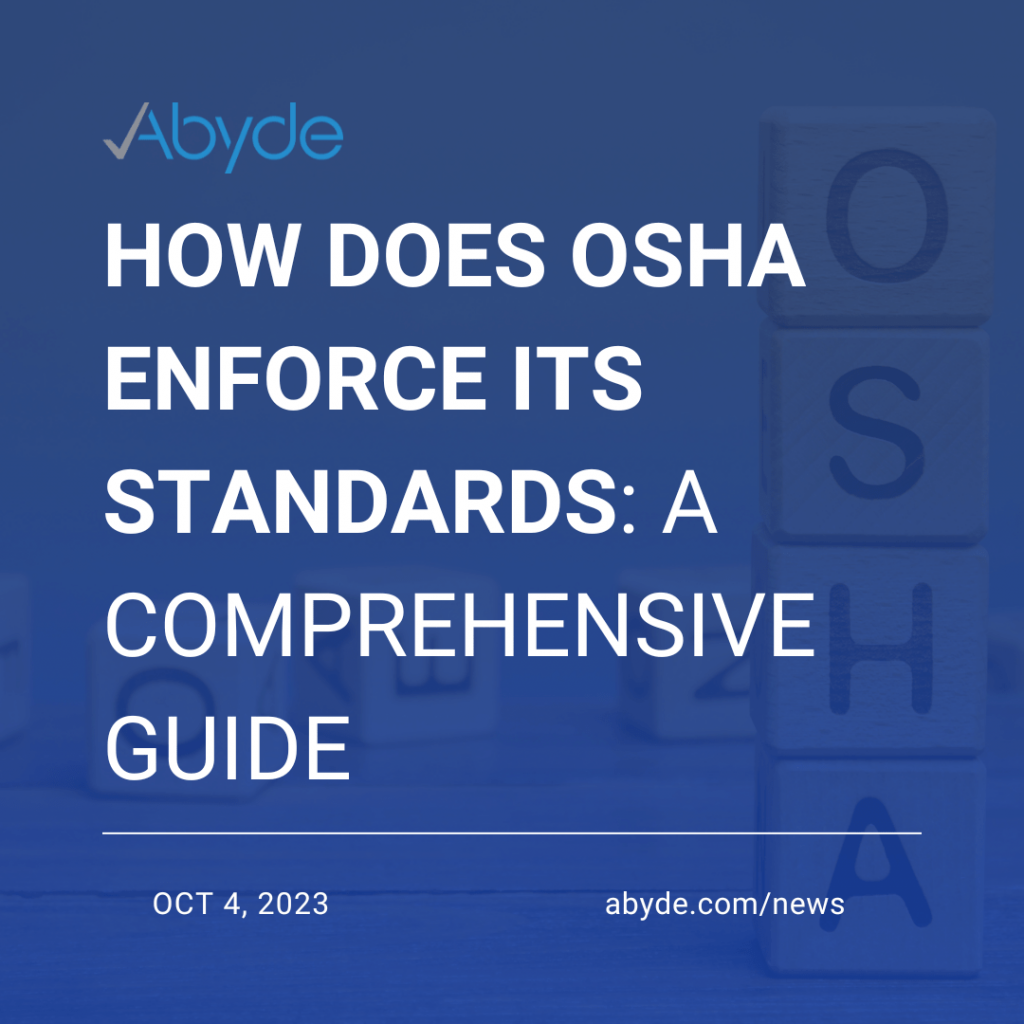October 4, 2023 Ensuring a safe and healthy workplace is a priority for employers across industries. The Occupational Safety and Health Administration (OSHA) plays a crucial role in setting and enforcing standards aimed at guaranteeing employee safety. But how does OSHA enforce these regulations? In this comprehensive guide, we break down the different mechanisms that OSHA employs to ensure compliance, including inspections, citations, and penalties. The Role of OSHA in Workplace Safety Established by the Occupational Safety and Health Act of 1970, OSHA is a federal agency responsible for maintaining health and safety regulations across workplaces in the United States. Its mission is to “assure safe and healthy working conditions for working men and women” (OSHA). Types of OSHA Inspections One of the primary ways that OSHA enforces its standards is through inspections, which can be categorized into various types: OSHA Citations and Penalties If a violation of OSHA standards is discovered, the agency issues citations that can carry hefty financial penalties. Fines can vary depending on the severity of the violation and can range from thousands to hundreds of thousands of dollars. Employers can contest these citations and may also be subjected to criminal charges in extreme cases (OSHA Penalties). OSHA’s Whistleblower Protections OSHA also enforces 22 federal whistleblower statutes to protect employees who report violations of various workplace safety regulations. This encourages employees to report unsafe conditions without fear of reprisal (OSHA Whistleblower Protection). How Abyde Can Help Ensuring OSHA compliance can be challenging, but you don’t have to do it alone. Abyde provides a comprehensive SaaS solution aimed at simplifying HIPAA and OSHA compliance for healthcare providers. Our platform helps you stay updated with the latest regulations, undergo training, and prepare for potential inspections, ensuring that you meet OSHA’s stringent standards. Conclusion OSHA plays a critical role in enforcing workplace safety standards across various industries. Through inspections, citations, and whistleblower protections, OSHA ensures that employers maintain a safe environment for their workforce. For more information about how Abyde can assist your healthcare organization in meeting OSHA and HIPAA compliance standards, contact us today. References Disclaimer: This article is for informational purposes only and does not serve as legal advice. By providing this guide, Abyde aims to simplify the complex landscape of OSHA enforcement mechanisms, helping healthcare providers focus on what they do best—caring for patients.
OSHA Inspection Process & Budget
October 11, 2022 With all of the OSHA inspections that are conducted throughout all the major sectors, you would be surprised to find out that the healthcare industry makes up 12% of those inspections! With the total average number of OSHA inspections leaning towards 34,000 a year – 14,000 of those inspections are related to the healthcare industry alone. You may be thinking to yourself how does the whole OSHA inspection process work? Well, you are in luck! Let’s get into the nitty gritty of it all. Anyone who is covered by the Occupational Safety and Health Act has the ability to request an OSHA inspection, or OSHA could also make an unrequested inspection. If and when an inspection is conducted, it is typically done with no notice at all – talk about an uninvited guest! For the inspection itself, it will include an opening conference, “walkaround” of the workplace, and a closing conference. The opening conference will begin once the inspector arrives and meets with the representatives. This part of the inspection is to be as short as possible and ensures that the inspection will cover all hazards that were mentioned in the complaint. After the opening conference, the inspector will conduct what’s called the “walkaround”. This is where the inspector and any representatives will check the facility for any safety and health hazards that were included in the initial complaint. The inspector could potentially check for any other hazards if they choose. The inspector would speak with any affected employees and employees are encouraged to point out any hazards and mention any past accidents, illnesses, and employee complaints. During the initial walkaround, the inspector may use any equipment to measure noise, dust, fumes or any other hazardous exposure. If you are unsure of what they are doing, don’t be afraid to ask. After the walkaround is complete, the OSHA inspector will bring any violations to the attention of the employer and employee representatives at the time they were discovered. Last thing is the closing conference, where the OSHA inspector where the OSHA inspector has to conduct a closing conference, whether it is jointly or separately, and will go over any apparent violations, ways to correct them, deadlines, and potential fines. And that wraps it up! Phew! Now let’s talk about MONEY! Every year OSHA introduces a plan and budget to substantiate their existence. In August, the Senate proposed an 11.1% funding increase for OSHA in the fiscal year of 2023. The Department of Labor, HHS, Education and Related Agencies Appropriations Act of 2023 proposes $679.8 million for OSHA in 2023, which is $68 million more than 2022. There is a House funding bill as well that proposes $712 million for OSHA; if the finalized budget is passed the amount would fall somewhere in between the two amounts that were proposed. With all that being said, having a larger budget could mean hiring more inspectors who could potentially knock on your door! Now that you’re familiar with the inspection process, wouldn’t it be nice to know you can be confident in your practice’s OSHA program? In walks Abyde – and we are a guest that usually brings doughnuts when we walk through your door!

